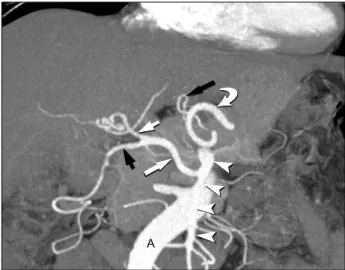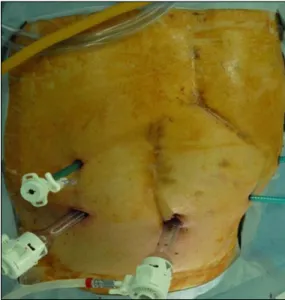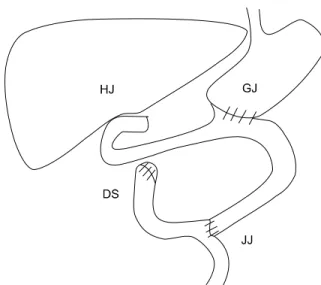CASE REPORT
DOI: 10.4174/jkss.2011.80.Suppl 1.S1
JKSS
Journal of the Korean Surgical Society pISSN 2233-7903ㆍeISSN 2093-0488
Received March 11, 2010, Accepted August 16, 2010 Correspondence to: Hyung-Ho Kim
Department of Surgery, Seoul National University Bundang Hospital, 166 Gumi-ro, Bundang-gu, Seongnam 463-707, Korea Tel: +82-31-787-7095, Fax: +82-31-787-4055, E-mail: hhkim@snubh.org
cc Journal of the Korean Surgical Society is an Open Access Journal. All articles are distributed under the terms of the Creative Commons Attribution Non-Commercial License (http://creativecommons.org/licenses/by-nc/3.0/) which permits unrestricted non-commercial use, distribution, and reproduction in any medium, provided the original work is properly cited.
Laparoscopy-assisted distal gastrectomy for gastric cancer after liver transplantation
Moon-Soo Lee
1, Eun-Young Kim
2, Ju-Hee Lee
1, Ye Seob Jee
3, Do Joong Park
1,2, Hyung-Ho Kim
1,2, So Yeon Kim
41Department of Surgery, Seoul National University Bundang Hospital, Seongnam, 2Department of Surgery, Seoul National University College of Medicine, Seoul, 3Department of Surgery, Dankuk University Hospital, Cheonan, 4Department of Radiology, Seoul National University Bundang Hospital, Seongnam, Korea
A case report described a 72-year-old man with a history of a deceased-donor liver transplantation (due to hepatitis B-asso- ciated end-stage liver cirrhosis) performed in 1994. The patient was diagnosed with renal cell carcinoma and pulmonary metastasis in 1997 and was successfully treated with radiofrequency ablation and thoracoscopic superior segmentectomy.
There was no evidence of newly diagnosed metastatic lesions or recurrence until the 19th post-operative month. Gastric can- cer was identified by endoscopy during a routine follow-up examination; the pre-pyloric antral lesion measured 1.5 cm in size and was histologically well-differentiated and confined to the submucosal layers on endoscopic ultrasound.
Laparoscopic gastrectomy and lymph node dissection (D1 + β) was successfully performed in March 2009, and the patient was discharged on the 5th post-operative day without complications. This suggests that laparoscopic surgery is one of the feasible methods for resection of gastric cancer in liver transplant patients.
Key Words: Laparoscopic gastrectomy, Liver transplantation, Gastric cancer
INTRODUCTION
The development of novel and effective immuno- suppressive agents has resulted in decreased graft re- jection and improved graft or patient survival. There has been an increase in the incidence of post-transplantation de novo cancer; this occurred after the widespread use of anti-rejection drugs. Previous studies have emphasized the necessity for frequent clinical follow-ups for early can- cer detection in transplant patients [1]. Minimally invasive surgery for surgical oncology is still controversial despite its popularity. Advancement of laparoscopic techniques
and improvement in instrumentation have occurred since the initial introduction of laparoscopic cholecystectomy.
Recent clinical trials have evaluated the safety and advan- tages of both laparoscopic and conventional open sur- geries, and laparoscopic surgery is feasible in cancer treat- ment [2]. To our knowledge, there are no case reports eval- uating laparoscopic gastric cancer surgery after liver transplantation. We describe a laparoscopic-assisted gas- trectomy procedure for post-transplantation gastric can- cer in the present study.
Fig. 1. Endoscopic finding after performing biopsies shows early gastric cancer, type IIa + IIc lesion on lesser curvature of the gastric antrum.
Fig. 2. Endoscopic ultrasound shows the lesion less than 15 cm with submucosal involvement.
Fig. 3. Pre-surgical computed tomography angiography demon- strated the replaced common hepatic artery originating from the superior mesenteric artery. The left gastric artery and the splenic artery originate separately from the celiac axis and the common hepatic artery. A, aorta; White short arrow, proper hepatic artery;
White long arrow, replaced common hepatic artery; Black short arrow, gastroduodenal artery; Black long arrow, left gastric artery;
Arrowheads, superior mesenteric artery; Curved arrow, splenic artery.
CASE REPORT
The patient was a 72-year-old man who had undergone a deceased-donor liver transplant for hepatitis B-asso- ciated end-stage liver cirrhosis in 1994 in a foreign country.
Renal cell carcinoma with pulmonary metastasis was di- agnosed in 1997 at our hospital and was successfully treat- ed with radiofrequency ablation and thoracoscopic supe- rior segmentectomy. There were no new metastatic lesions
or recurrence for 19 months post-operatively; however, gastric cancer was incidentally diagnosed under endos- copy during the regular follow-up period. The lesion was located in the pre-pyloric antrum and measured 1.5 cm (Fig. 1); it was histologically well-differentiated ad- enocarcinoma and was confined to the submucosa on en- doscopic ultrasound (Fig. 2).
The patient had other co-morbidities including hyper- tension and hyperlipidemia, and his current drugs in- cluded the immunosuppressive drug FK506 (Tacrolimus;
Fujisawa Pharmaceutical Co., Osaka, Japan) (2 mg) once per day without additional steroids and hepatitis B im- munoglobulin (Hepabig, Green Cross Co., Yongin, Korea) once per month. Pre-operative computed tomography re- vealed a replaced common hepatic artery which branched from the superior mesenteric artery (Fig. 3); this suggested that the recipient common hepatic artery was anasto- mosed to the replaced common hepatic artery at the site of the liver transplant. Pre-operative liver function tests were within normal limits.
The laparoscopic gastrectomy and lymph node dis- section (D1 + β) procedures were performed in March 2009
Fig. 4. Intra-operative view after dissection of the D1+β lymph node around the celiac axis. P, portal vein; L, divided left gastric artery; S, splenic artery; PH, pancreatic head.
Fig. 6. View of the hepaticojejunostomy and the hepatic hilum. HJ, hepaticojejunostomy; LH, left hepatic artery; B, bile duct; P, portal vein; PH, pancreatic head.
Fig. 5. Trocar site placements for the post-liver transplant laparoscopic gastrectomy procedure.
(Fig. 4). The patient was placed in a supine position under general anesthesia. A traditional chevron incision had been used for the previous liver transplantation and a right paramedian incision had been used for a previous open cholecystectomy. For the laparoscopic procedure, an 11-mm trocar was carefully inserted through an umbilical incision for the laparoscopic scope using the open techni- que; an additional two 5 mm trocars was inserted through the left upper and lower abdominal quadrants. Severe up- per abdominal adhesions were present, particularly be-
tween the liver and duodenum, but there was no evidence of metastatic lesions upon laparoscopic examination. The adhesions were carefully dissected, and trocars (5 mm and 12 mm) were inserted into the right abdominal wall (Fig.
5). We maintained a CO2 pneumoperitoneum below 12 mmHg secondary to hemodynamic instability due to old age and underlying disease. Previous antecolic Roux-en-Y hepaticojejunostomy and jejunojejunostomy sites were lo- cated (Fig. 6). The harmonic scalpel (Ethicon Endo- Surgery Inc., Cincinnati, OH, USA) was primarily used for dissection of adhesions surrounding the liver and lymph nodes, and tissue manipulation near hepatic-associated vessels was minimized during lymph node dissection due to anatomical change after liver transplantation. The tro- car incision was extended 5 to 6 cm transversely at the epi- gastrium after the intracorporeal procedure was com- pleted; specimen removal and the Roux-en-Y gastro- jejunostomy reconstruction proximal to the afferent loop jejunojejunostomy site was performed through this in- cision (Fig. 7). Surgical time was 300 minutes, and the esti- mated blood loss was 300 mL.
Fortunately, the final pathologic result was tumor con- fined to the mucosa without lymph node metastasis.
Tacrolimus level was measured daily monitoring acute post-operative rejection; pre-operative levels measured at 2.7 ng/mL and dropped to 1.5 ng/mL on the 3rd post-oper- ative day. However, there were no signs of acute rejection.
Fig. 7. This shows schematic drawing after laparoscopic distal gastrectomy. HJ, hepaticojejunostomy; GJ, gastrojejunostomy, DS, duodenal stump; JJ, jejunojejunostomy.
Other liver function tests including alkaline phosphatase, bilirubin were within normal range during post-operative period. The patient re-started tacrolimus with soft diet on the 3rd post-operative day, and was discharged on the 5th post-operative day without complications. To our knowl- edge, the patient is in good general health and has suffered no post-operative recurrence.
DISCUSSION
The incidence of de novo cancer in transplant patients has been reported from 5 to 15% [3]. De novo cancer and age-related cardiovascular complications are two leading causes of late mortality in liver transplant recipients.
Although the proportion of gastrointestinal de novo cancer is small, its development results in significant reductions in survival. The selection of appropriate patient treatment as well as early detection of de novo cancer through close follow-up is important for improvements in long-term survival [2].
Most patients have been treated by conventional open surgery secondary to concerns about adhesions and onco- logical safety. Laparoscopic surgery may have post-oper- ative benefits over conventional open surgery due to re- duced pain, faster return of bowel function, earlier oral
feeding, and shorter hospital stays. However, there were no significant differences in short-term morbidity and mortality [4]. Several preliminary reports have suggested that laparoscopic surgery for early gastric cancer is fea- sible in terms of the oncological safety, although it must be confirmed through ongoing prospective randomized con- trolled trials [5]. We think this was not easy operation, but in our situation was possible because operator had a lot of laparoscopy-assisted distal gastrectomy experiences al- most above 1,000 cases. Additionally, Adachi et al. [6] em- phasized the advantages of laparoscopic surgery, includ- ing the minimization of tissue injury and the suppression of immune function [6]. Laparoscopic surgery resulted in fewer inflammatory and immunologic reactions com- pared to conventional open surgery in another study [7].
Management of transplant patients involves a balance be- tween increasing doses of immunosuppressive agents (to prevent acute rejection) and decreasing doses (to suppress potential tumor activity). It is extremely important to min- imize the extent of fluctuation of immunologic activities during the operative period for the prevention of acute re- jection in the immunosuppressed patient.
The current treatment modality for early gastric cancer is determined by the presence of lymph node metastases in accordance with guidelines of the Japanese Research Society for Gastric Cancer [8]. Surgeons favor open surgi- cal curative procedures with lymph node dissections rath- er than endoscopic repairs for submucosal lesions because the probability of lymph node metastasis ranged from 5 to 20% [9]. This patient was diagnosed with a submucosal le- sion by pre-operative endoscopic ultrasound, and there was no evidence of recurrence or newly diagnosed meta- stasis during 19 months post-operatively. Therefore, we elected to perform laparoscopic curative surgery. Howev- er, endoscopic submucosal dissection and endoscopic mu- cosal resection could be considered alternative treatment options for early gastric cancer confined to mucosa with- out evidence of lymph node metastasis before deciding to undergo gastrectomy surgery.
Laparoscopic gastrectomy for early gastric cancer has been reported as a feasible minimally invasive surgical op- tion in elderly patients with comorbidities [10]. However, special precautions are required to address the car-
diopulmonary effects of pneumoperitoneum, systemic CO2 absorption, and anatomical changes resulting from previous transplant surgeries. Lymph node dissection near the portal veins and hepatic artery must be very care- fully performed due to adhesions adjacent to the lymph nodes with accurate anatomical information, particularly in liver transplant patients. Accordingly, less invasive treatment methods are suitable for sicker patients. The pa- tient in the present study underwent a more minimally in- vasive treatment course due to co-morbidities and ad- vanced age, and successful treatment included radio- frequency ablation, thoracoscopic surgery, and laparo- scopic gastrectomy. To our knowledge, this is the first case report to successfully use laparoscopic surgery to treat gastric cancer in liver transplant recipient patients. This data suggests that laparoscopic surgery is feasible for transplant patients if patients were appropriately selected.
CONFLICTS OF INTEREST
No potential conflict of interest relevant to this article was reported.
REFERENCES
1. Herrero JI, Alegre F, Quiroga J, Pardo F, Iñarrairaegui M, Sangro B, et al. Usefulness of a program of neoplasia sur-
veillance in liver transplantation: a preliminary report.
Clin Transplant 2009;23:532-6.
2. Colon Cancer Laparoscopic or Open Resection Study Group, Buunen M, Veldkamp R, Hop WC, Kuhry E, Jeekel J, et al. Survival after laparoscopic surgery versus open surgery for colon cancer: long-term outcome of a rando- mised clinical trial. Lancet Oncol 2009;10:44-52.
3. Valero JM, Rubio E, Moreno JM, Pons F, Sanchez-Turrion V, Cuervas-Mons V. De novo malignancies in liver tran- splantation. Transplant Proc 2003;35:709-11.
4. Kim MC, Jung GJ, Kim HH. Morbidity and mortality of laparoscopy-assisted gastrectomy with extraperigastric lymph node dissection for gastric cancer. Dig Dis Sci 2007;52:543-8.
5. Huscher CG, Mingoli A, Sgarzini G, Sansonetti A, Di Paola M, Recher A, et al. Laparoscopic versus open subtotal gas- trectomy for distal gastric cancer: five-year results of a randomized prospective trial. Ann Surg 2005;241:232-7.
6. Adachi Y, Shiraishi N, Shiromizu A, Bandoh T, Aramaki M, Kitano S. Laparoscopy-assisted Billroth I gastrectomy compared with conventional open gastrectomy. Arch Surg 2000;135:806-10.
7. Jung IK, Kim MC, Kim KH, Kwak JY, Jung GJ, Kim HH.
Cellular and peritoneal immune response after radical lap- aroscopy-assisted and open gastrectomy for gastric cancer.
J Surg Oncol 2008;98:54-9.
8. Japanese Gastric Cancer Association. Japanese classi- fication of gastric carcinoma - 2nd English edition. Gastric Cancer 1998;1:10-24.
9. An JY, Baik YH, Choi MG, Noh JH, Sohn TS, Kim S.
Predictive factors for lymph node metastasis in early gas- tric cancer with submucosal invasion: analysis of a single institutional experience. Ann Surg 2007;246:749-53.
10. Hwang SH, Park do J, Jee YS, Kim HH, Lee HJ, Yang HK, et al. Risk factors for operative complications in elderly pa- tients during laparoscopy-assisted gastrectomy. J Am Coll Surg 2009;208:186-92.


